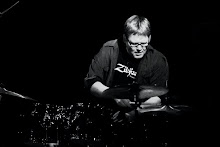In the second instalment of our Three Bloggers series, Cruise Ship Drummer , Four on the Floor , and I will be comparing notes on Miles Davis' classic 50s quintet album Milestones. I look forward to hearing my compatriot's insights on what was a very important recording in my development.
First of all, Milestones establishes Davis as a complete and utter badass. How? Let me count the ways…..
-Out of the seven tunes, four of them are 12 bar blues forms. (At least for the blowing. "Two Bass Hit"'s head form is a little different.) Miles, however achieves variety by varying the tempos and keys. He also plays piano on "Sid's Ahead" (apparently due to red Garland walking out after a disagreement) resulting in a largely cordless or minimal chording performance.
-Further variety is achieved on side two due to the modal nature of the title tune, and then the piano trio version of "Billy Boy". Yes, Miles is such a badass he doesn't even play on one of the tunes! Again, like all his albums, Miles understands how to structure a recording for maximum effect and drama. No wonder he started titling his work Directions in Music by Miles Davis. He played the whole band as well as the trumpet!
I will address some other general factors with the album before I get to Philly Joe's drumming on this.
Another way the solos are linked on this is how much trading there is. Not only between the horns and drums, but between the horns themselves. Stitching the whole tune together by use of the passing the baton idea of a soloist referencing the previous soloist's last idea is utilized throughout the recording, but particularly on the title track. Check it out…..
Also, for me, this very catchy tune reached me in a way that say, Parker's couldn't, with the level of knowledge I possessed when I heard it.
Okay, on to Philly.
The title track is also interesting because Philly Joe doesn't treat it as a typical Jazz Drum performance in that he mainly sticks to his click on 4 pattern throughout. I've never heard him discuss of how he conceived his playing on this tune, but I'm wondering if the slower harmonic rhythm and singable melody caused him to take this static, hypnotic approach more akin to Pop and Funk drumming than anything he had done previously. Regardless of source of inspiration, Philly's concept differentiates "Milestones" from the rest of the tracks on the album…
Also worth noting is that Philly only has one tom on this recording, most likely his mounted tom. For someone of his brilliance this isn't even remotely an issue, for he always gets the most out of what he's playing and orchestrating. I actually learned his trades on "Dr. Jeckyll". Despite the tempo, there's a lot of great Philly language that isn't super difficult. The trades on "Sid's Ahead" are also great for working on one's slow tempo trading language. In general, I find Philly's playing a little less slick than other recordings of his, and I actually prefer it. It's also easier to figure out what he's doing when he only has one tom, although I find the splashy cymbal sound can create the opposite effect when attempting to check out his ride patterns.
Finally, if you want to learn to play brushes, you need to check Philly's work on "Billy Boy".
All in all, Milestones is an important and innovative, yet listener-friendly Jazz album that contains all the elements of great music. A timeless classic, and everyone serious about this music should spend time with it. :)

No comments:
Post a Comment